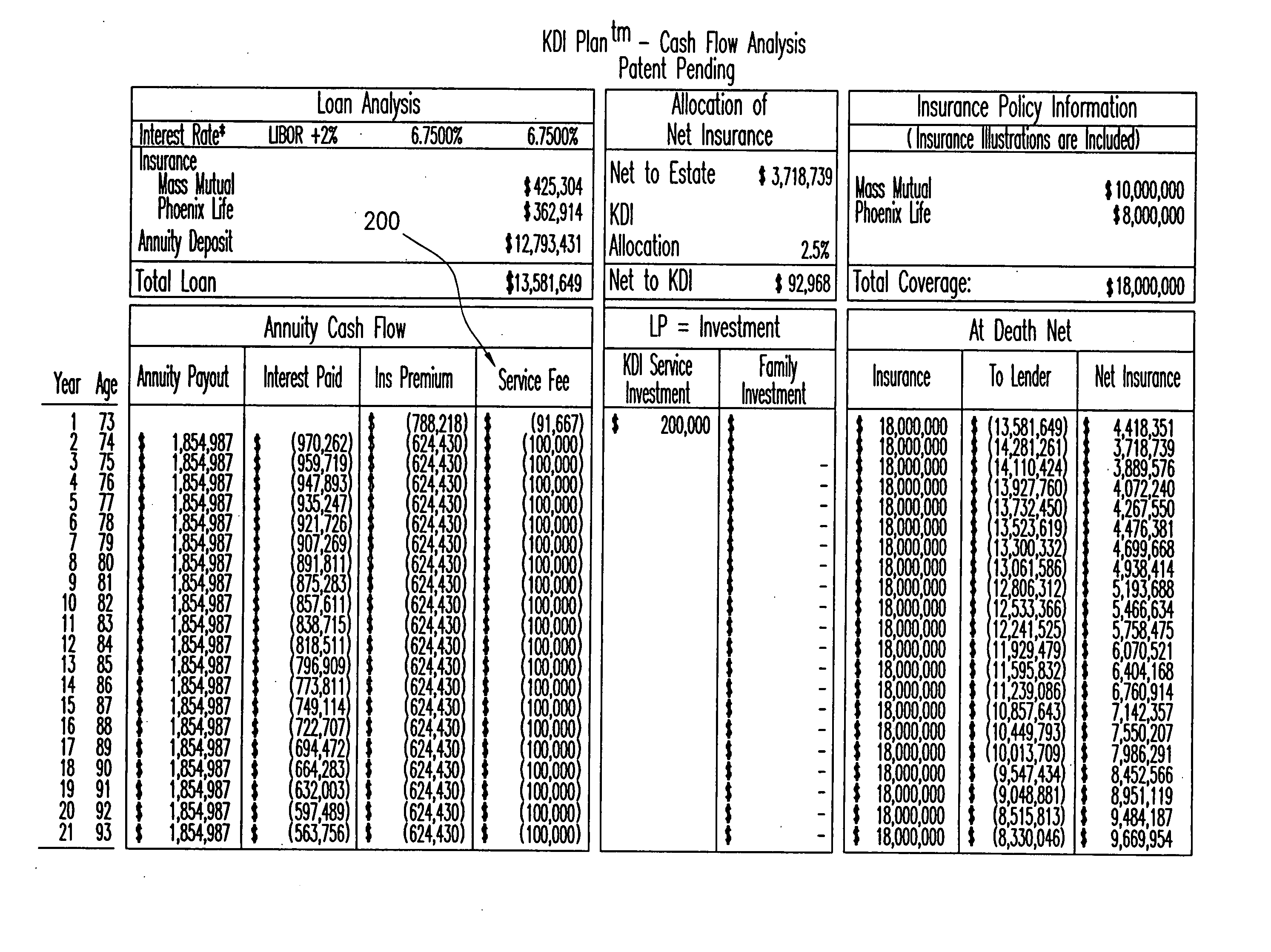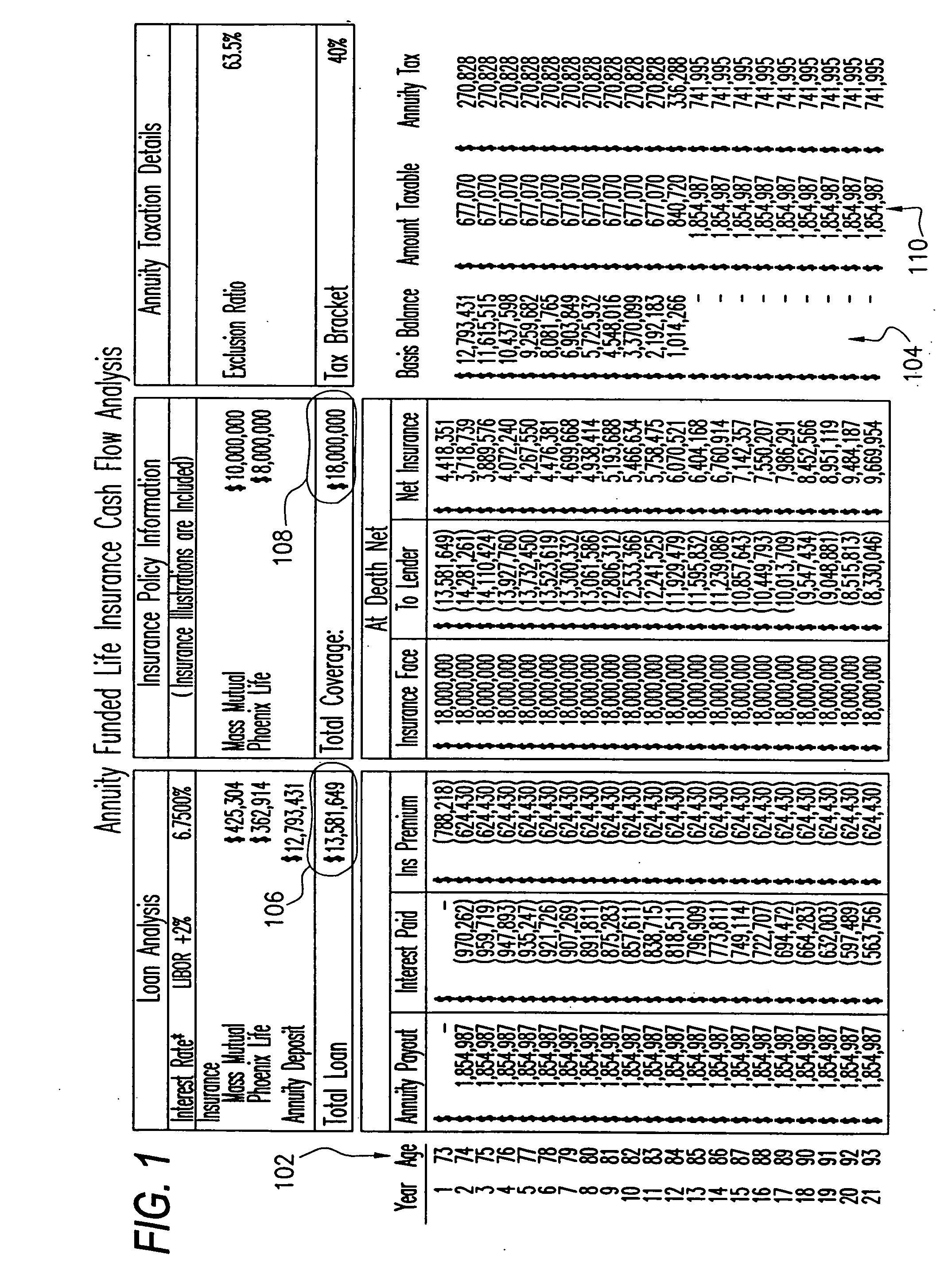System for funding, analyzing and managing life insurance policies funded with annuities
a life insurance and annuity technology, applied in the system field, can solve the problems of limiting the market for such purchases, u.s. internal revenue service has attacked many systems involving life insurance products, and many systems have failed to meet the needs of such purchases
- Summary
- Abstract
- Description
- Claims
- Application Information
AI Technical Summary
Benefits of technology
Problems solved by technology
Method used
Image
Examples
first and second embodiments
[0046] The first and second embodiments have the annuity purchased by the life insurance policy as an internal investment of the policy (first embodiment), or as an investment of the life insurance company (second embodiment). As shown in FIG. 3, the first embodiment uses money that was paid to the policy 312 using money 316 borrowed by the policy 312 from a third party lender 318. As shown in FIG. 3, because of regulatory requirements requiring diversification, each life insurance policy 312 will generally have multiple annuities 302. Depending on the type of life insurance policy 312 used, the structure internal to the policy 312 may require a trust 314 or a business entity to conduct the transaction. Initially, each annuity and loan will be tracked to a particular policy 312, as indicated by the arrows 304,306, and 308FIG. 3. Arrow 310 depicts money flowing to the life insurance policy after deduction of the $100,000 Service Fee 200 indicated in FIG. 2, indicated by the box “Mort...
third embodiment
[0051] Embodiments three and four include the administration of investing in widely available insurance contracts through a unique trust, business entity and partnership arrangement. This arrangement is employed in order to closely track and direct the income tax liability 502, as shown in FIG. 5. In the third and fourth embodiments, investment growth no longer occurs inside an insurance policy, and is therefore no longer characterized as “inside build-up”. Instead, owners of management company 504 that are normal business entities but have either substantial income tax credits, tax-favored status, or otherwise reduced income tax exposure, receive a significant amount of the income tax liability. This improves the cash flow available to fund the other components of the arrangement and therefore significantly widens its marketability.
[0052] Examples of tax favored entities can include businesses established within the U.S. Virgin Islands, as approved by the U.S. Congress. There are ...
fourth embodiment
[0056] The fourth embodiment differs from the third in that the annuity is purchased by a subsidiary 604 of the tax favored business entity so that the tax obligation is passed to the tax-favored company 508, and the benefit is paid as taxable income in the form of a dividend 602, as shown in FIG. 6. Because of this, the fourth embodiment is more conducive to charities than the third embodiment. This is because where a charity is involved, a dividend 602 would be an acceptable distribution method since in most cases this would not be taxed to the charity. Conversely, the partnership 504 income (K-1) of the third embodiment would be a more difficult distribution method for a charity.
[0057] A further modification exists for all four embodiments discussed above. That modification is that borrowed money is not used, but that the annuity is paid for from the assets of the settlor or customer. FIG. 7 shows the first embodiment of FIG. 3 modified to substitute personal assets 706 for refe...
PUM
 Login to View More
Login to View More Abstract
Description
Claims
Application Information
 Login to View More
Login to View More - R&D
- Intellectual Property
- Life Sciences
- Materials
- Tech Scout
- Unparalleled Data Quality
- Higher Quality Content
- 60% Fewer Hallucinations
Browse by: Latest US Patents, China's latest patents, Technical Efficacy Thesaurus, Application Domain, Technology Topic, Popular Technical Reports.
© 2025 PatSnap. All rights reserved.Legal|Privacy policy|Modern Slavery Act Transparency Statement|Sitemap|About US| Contact US: help@patsnap.com



